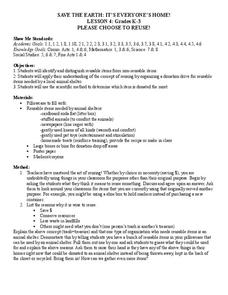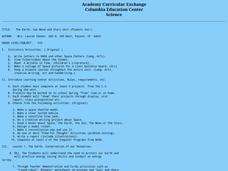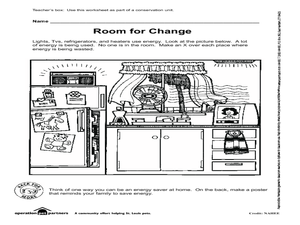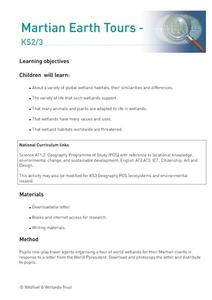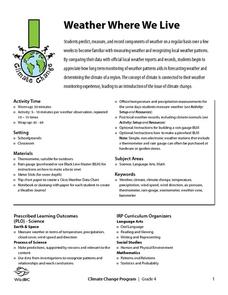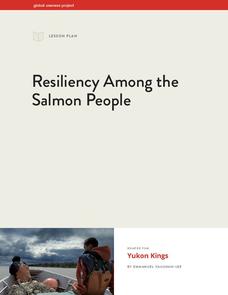Mary Pope Osborne, Classroom Adventures Program
Mummies in the Morning Egyptian pyramids, hieroglyphics
Visit the Magic Treehouse and take your class on a trip through time with a reading of the children's book Mummies in the Morning. Using the story to spark an investigation into Egyptian culture, this literature unit engages...
Curated OER
The Dynamic Earth
Students use the Internet to investigate earthquakes and plate tectonics. For this plate tectonics lesson, students complete a web quest with multiple links and activity types relating to earthquakes and volcanoes. They connect the...
Curated OER
Earth and Beyond!
Students investigate one or more of the following topics and develop a plan for the future regarding it: global warming, lunar exploration, space travel, Mars exploration, or terraforming. They disucss the audio files and the video that...
Curated OER
Save the Earth: It's Everyone's Home!
Students organize a donation drive based on the concept of reusing items for an animal shelter. In this reusing items lesson plan, students distinguish between reusable and non reusable items, have a donation drive, and use the...
Curated OER
Journey to the Center of the Earth I
Students identify the elements of science fiction and write their own example. In this Journey to the Center of the Earth lesson students complete several activities about science fiction, authors and novels.
Curated OER
Wow, Saturn Is Much Bigger Than Earth!
Young scholars compare and contrast the sizes of Earth and Saturn. They create scale illustrations of each planet and label them. They share their models with the class.
Curated OER
The Earth, Sun, Moon, And Stars
Fifth graders explore the solar system. In this solar system unit, 5th graders investigate numerous projects while rotating through learning centers. Students write about space and construct a space shuttle model. Students practice map...
Curated OER
Rockin? Chalk (Integrating science - make own chalk)
Students use plaster of Paris, talc, and cornstarch to create their own chalk. They hypothesize what mixture of ingredients produce the "best" chalk. Students discuss what they think are the characteristics of the "best" chalk.
Curated OER
Save the Earth, it's Everyone's Home!
Students examine trash for items to recycle and reuse. In this trash lesson, students explore how people in the community can use recycled and reused items as they play a recycling game.
Curated OER
Martian Earth Tours
Students study a variety of global wetland habitats, their similarities and differences. They examine the variety of life that such wetlands support and determine that many animals and plants are adapted to life in wetlands, that...
Curated OER
Connection to Fine Arts: Carbon-Dating Masterpieces
In this carbon dating worksheet, students read about how carbon-14 is used to date historical paintings. They answer questions about carbon dating and its importance.
Curated OER
The Potential Consequences of Climate Variability and Change
Students analyze the impact of climate variability and change utilizing a broad span of topics over a wide range of grade levels. This three lesson plan unit is easily adapted for the various instructional levels listed.
NOAA
Endangered Species Origami
Make sea turtle or whale origami in a hands-on activity that provides instructions for folding and facts for learning about each.
Wild BC
Weather Where We Live
Over a span of two weeks or more, mini meteorologists record weather-related measurements. What makes this particular resource different from others covering similar activities are the thorough details for the teacher and printables for...
Penn Museum
Penn Museum: China Gallery
Invite your learners to take a closer look at the art and mathematical function of dome buildings as designed by the ancient Romans. In the next segment of this attractive activity set, your young historians will then learn about ancient...
Global Oneness Project
Resiliency Among the Salmon People
Is losing cultural traditions the cost of social progress, or should people make stronger efforts to preserve these traditions? High schoolers watch a short film about the native Yup'ik people in Alaska and how they handle the shifts in...
Curated OER
Power On to Present- What You Know About Where You Went
Third graders write an essay. In this earth's layers instructional activity, 3rd graders view a power point presentation on layers of the earth and discuss it. They write a short essay on the layers and their characteristics. They use...
Curated OER
Puzzle it Out
Learners study the Earth's climatic system and construct a puzzle that names all of the pieces of the components involved. In this Climate lesson, students draw a picture on a puzzle piece depicting a specific component....
Curated OER
To Rot or Not!
Students discover that composting helps reduce landfill waste and is good for the soil. They explore the techniques of composting through a variety of media, art activities and hands-on experience.
Curated OER
Renewable Energy Sentences
Students construct sentences using nouns and verbs from a "renewable energy" word bank. In this cross curriculum ecology and sentence structure grammar and mechanics lesson, students listen to the book Our Earth: Clean Energy by Peggy...
California Academy of Science
Energy: A Day in My Life
If only we could harness the energy of fifth graders, our energy problems would be over! The class discusses where different forms of energy come from and how we use them. They complete a chart of the activities that they do daily...
Curated OER
Understanding the Roots
Students investigate the parts of a flower. In this earth science lesson, students read the book The Magic School Bus Plants Seeds and identify various plant parts. Students construct a model of a flowering plant from various art supplies.
Curated OER
Crater Lakes and the Volcanoes of the Cascade Mountains
Learners study volcanoes. In this Earth science lesson plan, students read, discuss and take notes on the volcanoes of the Cascade Mountains. This lesson also includes an art project.
Curated OER
Four Seasons
Students identify the change in the seasons. In this earth science lesson, students describe weather of each of the seasons and illustrate pictures of each season. Students discuss their illustrations with their classmates.



